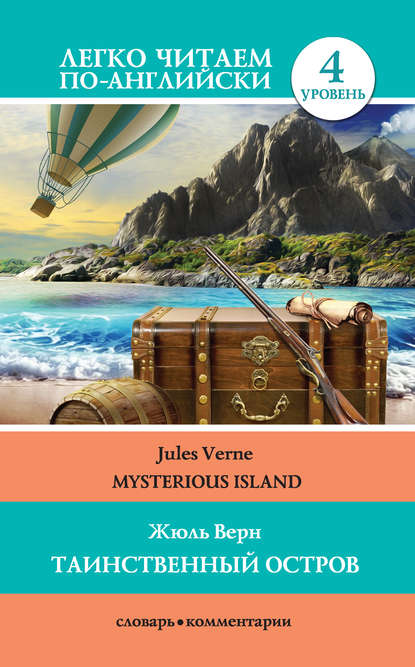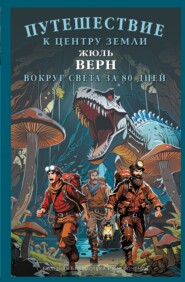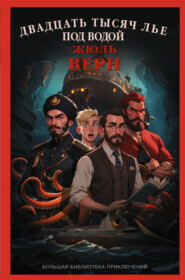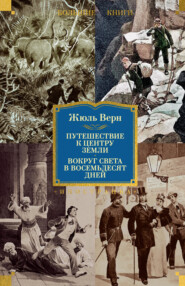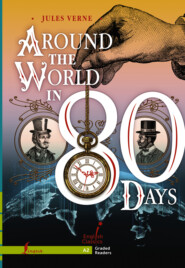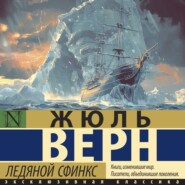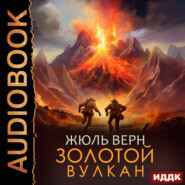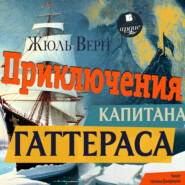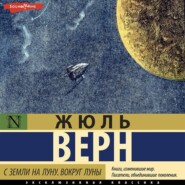По всем вопросам обращайтесь на: info@litportal.ru
(©) 2003-2024.
✖
Таинственный остров / Mysterious Island
Настройки чтения
Размер шрифта
Высота строк
Поля
“But who lighted it?” said the sailor.
“The sun.”
The sailor could not believe his eyes.
“Do you have a burning-glass[42 - burning-glass – увеличительное стекло], sir?” asked Herbert of Cyrus Smith.
“No, my boy,” said he, “but I made one.”
And he showed his lens. It was simply the two glasses, from his own watch and the reporter’s, which he had taken out, filled with water, and stuck together at the edges with a little clay. Thus he had made a veritable burning-glass, and by concentrating the solar rays on some dry moss had set it on fire.
With the help of Neb, the sailor arranged the spit. The engineer and his companion had made good use of their day[43 - had made good use of their day – провели день с пользой]. Smith had almost entirely recovered his strength. They had a pleasant supper. The engineer said little; he was planning for the next day. After supper, the party lay down to sleep. The morning found them fresh and eager for the expedition.
Everything was ready. At half past 7 they left the Chimneys, each with a stout cudgel. By Pencroff’s advice, they took the route of the previous day, which was the shortest way to the mountain. They turned the southern angle, and followed the left bank of the river. They took the path under the evergreens, and soon reached the northern border of the forest. The soil was flat and swampy, then dry and sandy. Among the trees appeared a few animals. The engineer was going straight for the top of the mountain.
The mountain was composed of two cones. The first was truncated about 2,500 feet up, and supported by fantastic spurs. Between these spurs were narrow valleys. On the northeast side of the mountain, vegetation was scanty.
On the first cone lay the second one, slightly rounded towards the summit. The surface seemed utterly bare. The object of the expedition was to reach the top of this cone, and their best way was along the edge of the spurs.
“We are in a volcanic country,” said Cyrus Smith, as they began to climb, little by little, up the side of the spurs. They were gradually ascending. At noon, when the little company halted to dine at the foot of a great clump of firs, they were still half way from the first plateau, and could hardly reach it before nightfall. From this point the sea stretched broad beneath their feet. On the left they could see directly north for several miles; but the northwest was concealed from them.
At 1 o’clock, the ascent again began. The easiest route slanted upwards towards the southwest, through the thick copse. Leaving the copse, the climbers ascended for a hundred feet up a very steep hill, and reached a terrace, almost bare of trees, whose soil was evidently volcanic. From hence, their course was a zigzag towards the east. Neb and Herbert led the way, then came Smith and the reporter; Pencroff was last.
They had come across large animals, with thick horns, curved backwards and flattened at the end, and with woolly fleece. They were not the common sheep. Their name, according to Herbert, was а Moufflon[44 - Moufflon – муфлон].
As the ascension continued, the traces of lava were more frequent, and little sulphur springs[45 - little sulphur springs – сольфаторы (небольшие вулканы)] intercepted their route. As they neared the first plateau, formed by the truncation of the lower cone, the ascent became very difficult. By 4 o’clock the last belt of trees had been passed. Fortunately for the engineer and his party, it was a pleasant, mild day. The sky overhead was extremely bright and clear. A perfect calm reigned around them. The sun was hidden by the upper mountain, which cast its shadow westward to the edge of the sea.
There were only 500 feet between the explorers and the plateau where they meant to encamp for the night. Little by little the evening set in, and it was almost night when the party, tired out by a seven hours’ climb, arrived at the top of the first cone.
Now they must pitch their camp, and think of supper and sleep. The sailor built up a fireplace with huge stones, while Neb and Herbert went after the combustibles[46 - went after the combustibles – отправились за дровами]. They soon came back with a load of thistles.
The night was beautiful and still; and not yet very dark. They walked together in silence. Sometimes the plateau was wide and easy, sometimes very encumbered with rubbish. There were yet 1,000 feet to climb. Fortunately, the long and sinuous declivities described a winding staircase, and greatly helped their ascent. The volcano was not only quiet, but extinct.
It was nearly 8 o’clock when they set foot on the summit[47 - set foot on the summit – вышли на вершину] of the cone. The darkness was by this time complete, and they could hardly see a couple of miles around them. Was the land an island, or the eastern extremity of a continent? They could not yet discover. At one point of the horizon suddenly appeared a vague light, which slowly sank as the clouds mounted to the zenith. The line of the horizon was now cloudless, and as the moon touched it, the engineer seized the boy’s hand.
“An island!” said he.
Chapter XI
A half hour later they walked back to the camp. The land was an island, and tomorrow they would consider what to do.
The next day, March 30, after a hurried breakfast, they started out for the summit of the volcano. All desired to see the isle on which perhaps they were to spend their lives. It was about 7 o’clock in the morning when they left the camp.
“Bah!” said Pencroff, “we got out of Richmond without the permission of the authorities, and it will be strange if we can’t get away some time from this place!”
It was a superb day, and the southern side of the mountain was bathed in sunlight. The crater was a huge shaft gradually opening to a height of 1,000 feet above the plateau. The interior of the crater was easily scaled. They saw on the way traces of ancient lava. As to the volcano chimney, its depth could not be estimated by the eye, for it was lost in obscurity. Before 8 o’clock, the party was standing at the summit of the crater.
“The sea! The sea everywhere!” was the universal exclamation. There it lay, an immense sheet of water around them on every side. Nothing appeared to the horizon-line, a radius of more than fifty miles. Not a sail was in sight. Around the island stretched a desert infinity of ocean.
Silent and motionless, they surveyed every point of the horizon. Then they looked down upon their island, and the silence was broken by Spilett:
“How large do you think this island is?”
“It seemed small enough in the midst of the infinite ocean.”
“My friends,” said Smith, “if I am not mistaken, the coast of the island is more than 100 miles around.”
If Smith was right, the island would be about the size of Malta[48 - Malta – Мальта]; but it was more irregular than it. The eastern coast, upon which the castaways had landed, was a decided curve, embracing a large bay. On the northeast, two other capes shut in the bay, and between them lay a narrow gulf. From northeast to northwest the coast was round and flat, like the skull of a wild beast; then came a sort of indeterminate hump, whose centre was occupied by the volcanic mountain. From this point the coast ran directly north and south. For twothirds of its length it was bordered by a narrow creek; then it finished in along cue, like the tail of a gigantic alligator. The narrowest part of the island, between the Chimneys and the creek, on the west, was ten miles wide, but its greatest length was not less than thirty miles.
The southern part, from the shore to the mountain, was covered with woods; the northern part was arid and sandy. Between the volcano and the eastern coast there was a lake, surrounded by evergreens.
“So, then, it is a fresh water lake?” asked Pencroff.
“Yes, of course,” said the engineer.
“I can see a little river flowing into it,” said Herbert, pointing to a narrow brook.
The volcano did not occupy the centre of the island. It rose in the northwest, and seemed to indicate the dividing line of the two zones. On the southwest, south, and southeast, the beginnings of the spurs were lost in masses of verdure.
They remained for an hour at the summit of the mountain. The island lay stretched before them like a plan in relief[49 - a plan in relief – рельефная карта], with its different tints, green for the forests, yellow for the sands, blue for the water. They understood the configuration of the entire island, but there remained a great question: was the island inhabited? It was the reporter who put this question. Nowhere could they perceive the handiwork of man; no late settlement on the beach, not even a lonely cabin or a fisherman’s hut. No smoke rising on the air.
The exploration of the island was finished, its configuration determined, a map of it drawn, its size calculated. They had only now to descend the declivities of the mountain, and to examine into the animal, vegetable, and mineral resources of the land. But before giving the signal of departure, Cyrus Smith, in a calm, grave voice, addressed his companions.
“Look, my friends, upon this little corner of the earth. Here, perhaps, we may long dwell.”
“Mr. Smith,” said the sailor, “we will make a little America here. We will build cities, lay railroads, establish telegraphs. We should not consider ourselves any longer as castaways, but as colonists. Well, let’s start for the Chimneys!”
“One minute, my friends,” said the engineer; “let’s name the island, as well as the capes, promontories, and water-courses, which we see before us.”
“Yes,” said Smith, “for instance, let us call the great bay to the east Union Bay[50 - Union Bay – бухта Соединения], the southern indentation Washington Bay[51 - Washington Bay – бухта Вашингтона], the mountain on which we are standing Mount Franklin[52 - Mount Franklin – гора Франклина], the lake beneath our feet Lake Grant[53 - Lake Grant – озеро Гранта]. These names will recall our country and the great citizens who have honored it. What will you say, my friends?”
The engineer’s proposal was unanimously applauded. Spilett put down the names over the proper places, and the geographical nomenclature of the island was complete.
“Now,” said the reporter, “to that peninsula projecting from the southwest I propose to give the name of Serpentine Peninsula[54 - Serpentine Peninsula – полуостров Извилистый], and to call the twisted curve at the termination of it Reptile End[55 - Reptile End – Змеиный мыс], for it is just like a snake’s tail.”
“And the other extremity of the island,” said Herbert, “the gulf so like an open pair of jaws, let us call it Shark Gulf[56 - Shark Gulf – залив Акулы].”
“Good enough,” said Pencroff, “and we may complete the figure by calling the two capes North Mandible[57 - North Mandible – Северная Челюсть] and South Mandible[58 - South Mandible – Южная Челюсть]. Now we must name the southwestern extremity of the island.
“Claw Cape[59 - Claw Cape – мыс Коготь],” suggested Neb.
The river with fresh water they called the Mercy[60 - the Mercy – река Благодарения]. The islet on which they first set foot, was Safety Island[61 - Safety Island – остров Спасения]; the plateau at the top of the high granite wall above the Chimneys, from which the whole sweep of the bay was visible, Prospect Plateau[62 - Prospect Plateau – плато Кругозора]; and, finally, that mass of impenetrable woods which covered Serpentine Peninsula, the Forests of the Far West[63 - Forests of the Far West – леса Дальнего Запада].
All was settled, and the colonists were about to descend the mountain, when Pencroff cried:
“Why, what idiots we are!”
“Why so?” said Spilett, who had closed his note-book.
“The sun.”
The sailor could not believe his eyes.
“Do you have a burning-glass[42 - burning-glass – увеличительное стекло], sir?” asked Herbert of Cyrus Smith.
“No, my boy,” said he, “but I made one.”
And he showed his lens. It was simply the two glasses, from his own watch and the reporter’s, which he had taken out, filled with water, and stuck together at the edges with a little clay. Thus he had made a veritable burning-glass, and by concentrating the solar rays on some dry moss had set it on fire.
With the help of Neb, the sailor arranged the spit. The engineer and his companion had made good use of their day[43 - had made good use of their day – провели день с пользой]. Smith had almost entirely recovered his strength. They had a pleasant supper. The engineer said little; he was planning for the next day. After supper, the party lay down to sleep. The morning found them fresh and eager for the expedition.
Everything was ready. At half past 7 they left the Chimneys, each with a stout cudgel. By Pencroff’s advice, they took the route of the previous day, which was the shortest way to the mountain. They turned the southern angle, and followed the left bank of the river. They took the path under the evergreens, and soon reached the northern border of the forest. The soil was flat and swampy, then dry and sandy. Among the trees appeared a few animals. The engineer was going straight for the top of the mountain.
The mountain was composed of two cones. The first was truncated about 2,500 feet up, and supported by fantastic spurs. Between these spurs were narrow valleys. On the northeast side of the mountain, vegetation was scanty.
On the first cone lay the second one, slightly rounded towards the summit. The surface seemed utterly bare. The object of the expedition was to reach the top of this cone, and their best way was along the edge of the spurs.
“We are in a volcanic country,” said Cyrus Smith, as they began to climb, little by little, up the side of the spurs. They were gradually ascending. At noon, when the little company halted to dine at the foot of a great clump of firs, they were still half way from the first plateau, and could hardly reach it before nightfall. From this point the sea stretched broad beneath their feet. On the left they could see directly north for several miles; but the northwest was concealed from them.
At 1 o’clock, the ascent again began. The easiest route slanted upwards towards the southwest, through the thick copse. Leaving the copse, the climbers ascended for a hundred feet up a very steep hill, and reached a terrace, almost bare of trees, whose soil was evidently volcanic. From hence, their course was a zigzag towards the east. Neb and Herbert led the way, then came Smith and the reporter; Pencroff was last.
They had come across large animals, with thick horns, curved backwards and flattened at the end, and with woolly fleece. They were not the common sheep. Their name, according to Herbert, was а Moufflon[44 - Moufflon – муфлон].
As the ascension continued, the traces of lava were more frequent, and little sulphur springs[45 - little sulphur springs – сольфаторы (небольшие вулканы)] intercepted their route. As they neared the first plateau, formed by the truncation of the lower cone, the ascent became very difficult. By 4 o’clock the last belt of trees had been passed. Fortunately for the engineer and his party, it was a pleasant, mild day. The sky overhead was extremely bright and clear. A perfect calm reigned around them. The sun was hidden by the upper mountain, which cast its shadow westward to the edge of the sea.
There were only 500 feet between the explorers and the plateau where they meant to encamp for the night. Little by little the evening set in, and it was almost night when the party, tired out by a seven hours’ climb, arrived at the top of the first cone.
Now they must pitch their camp, and think of supper and sleep. The sailor built up a fireplace with huge stones, while Neb and Herbert went after the combustibles[46 - went after the combustibles – отправились за дровами]. They soon came back with a load of thistles.
The night was beautiful and still; and not yet very dark. They walked together in silence. Sometimes the plateau was wide and easy, sometimes very encumbered with rubbish. There were yet 1,000 feet to climb. Fortunately, the long and sinuous declivities described a winding staircase, and greatly helped their ascent. The volcano was not only quiet, but extinct.
It was nearly 8 o’clock when they set foot on the summit[47 - set foot on the summit – вышли на вершину] of the cone. The darkness was by this time complete, and they could hardly see a couple of miles around them. Was the land an island, or the eastern extremity of a continent? They could not yet discover. At one point of the horizon suddenly appeared a vague light, which slowly sank as the clouds mounted to the zenith. The line of the horizon was now cloudless, and as the moon touched it, the engineer seized the boy’s hand.
“An island!” said he.
Chapter XI
A half hour later they walked back to the camp. The land was an island, and tomorrow they would consider what to do.
The next day, March 30, after a hurried breakfast, they started out for the summit of the volcano. All desired to see the isle on which perhaps they were to spend their lives. It was about 7 o’clock in the morning when they left the camp.
“Bah!” said Pencroff, “we got out of Richmond without the permission of the authorities, and it will be strange if we can’t get away some time from this place!”
It was a superb day, and the southern side of the mountain was bathed in sunlight. The crater was a huge shaft gradually opening to a height of 1,000 feet above the plateau. The interior of the crater was easily scaled. They saw on the way traces of ancient lava. As to the volcano chimney, its depth could not be estimated by the eye, for it was lost in obscurity. Before 8 o’clock, the party was standing at the summit of the crater.
“The sea! The sea everywhere!” was the universal exclamation. There it lay, an immense sheet of water around them on every side. Nothing appeared to the horizon-line, a radius of more than fifty miles. Not a sail was in sight. Around the island stretched a desert infinity of ocean.
Silent and motionless, they surveyed every point of the horizon. Then they looked down upon their island, and the silence was broken by Spilett:
“How large do you think this island is?”
“It seemed small enough in the midst of the infinite ocean.”
“My friends,” said Smith, “if I am not mistaken, the coast of the island is more than 100 miles around.”
If Smith was right, the island would be about the size of Malta[48 - Malta – Мальта]; but it was more irregular than it. The eastern coast, upon which the castaways had landed, was a decided curve, embracing a large bay. On the northeast, two other capes shut in the bay, and between them lay a narrow gulf. From northeast to northwest the coast was round and flat, like the skull of a wild beast; then came a sort of indeterminate hump, whose centre was occupied by the volcanic mountain. From this point the coast ran directly north and south. For twothirds of its length it was bordered by a narrow creek; then it finished in along cue, like the tail of a gigantic alligator. The narrowest part of the island, between the Chimneys and the creek, on the west, was ten miles wide, but its greatest length was not less than thirty miles.
The southern part, from the shore to the mountain, was covered with woods; the northern part was arid and sandy. Between the volcano and the eastern coast there was a lake, surrounded by evergreens.
“So, then, it is a fresh water lake?” asked Pencroff.
“Yes, of course,” said the engineer.
“I can see a little river flowing into it,” said Herbert, pointing to a narrow brook.
The volcano did not occupy the centre of the island. It rose in the northwest, and seemed to indicate the dividing line of the two zones. On the southwest, south, and southeast, the beginnings of the spurs were lost in masses of verdure.
They remained for an hour at the summit of the mountain. The island lay stretched before them like a plan in relief[49 - a plan in relief – рельефная карта], with its different tints, green for the forests, yellow for the sands, blue for the water. They understood the configuration of the entire island, but there remained a great question: was the island inhabited? It was the reporter who put this question. Nowhere could they perceive the handiwork of man; no late settlement on the beach, not even a lonely cabin or a fisherman’s hut. No smoke rising on the air.
The exploration of the island was finished, its configuration determined, a map of it drawn, its size calculated. They had only now to descend the declivities of the mountain, and to examine into the animal, vegetable, and mineral resources of the land. But before giving the signal of departure, Cyrus Smith, in a calm, grave voice, addressed his companions.
“Look, my friends, upon this little corner of the earth. Here, perhaps, we may long dwell.”
“Mr. Smith,” said the sailor, “we will make a little America here. We will build cities, lay railroads, establish telegraphs. We should not consider ourselves any longer as castaways, but as colonists. Well, let’s start for the Chimneys!”
“One minute, my friends,” said the engineer; “let’s name the island, as well as the capes, promontories, and water-courses, which we see before us.”
“Yes,” said Smith, “for instance, let us call the great bay to the east Union Bay[50 - Union Bay – бухта Соединения], the southern indentation Washington Bay[51 - Washington Bay – бухта Вашингтона], the mountain on which we are standing Mount Franklin[52 - Mount Franklin – гора Франклина], the lake beneath our feet Lake Grant[53 - Lake Grant – озеро Гранта]. These names will recall our country and the great citizens who have honored it. What will you say, my friends?”
The engineer’s proposal was unanimously applauded. Spilett put down the names over the proper places, and the geographical nomenclature of the island was complete.
“Now,” said the reporter, “to that peninsula projecting from the southwest I propose to give the name of Serpentine Peninsula[54 - Serpentine Peninsula – полуостров Извилистый], and to call the twisted curve at the termination of it Reptile End[55 - Reptile End – Змеиный мыс], for it is just like a snake’s tail.”
“And the other extremity of the island,” said Herbert, “the gulf so like an open pair of jaws, let us call it Shark Gulf[56 - Shark Gulf – залив Акулы].”
“Good enough,” said Pencroff, “and we may complete the figure by calling the two capes North Mandible[57 - North Mandible – Северная Челюсть] and South Mandible[58 - South Mandible – Южная Челюсть]. Now we must name the southwestern extremity of the island.
“Claw Cape[59 - Claw Cape – мыс Коготь],” suggested Neb.
The river with fresh water they called the Mercy[60 - the Mercy – река Благодарения]. The islet on which they first set foot, was Safety Island[61 - Safety Island – остров Спасения]; the plateau at the top of the high granite wall above the Chimneys, from which the whole sweep of the bay was visible, Prospect Plateau[62 - Prospect Plateau – плато Кругозора]; and, finally, that mass of impenetrable woods which covered Serpentine Peninsula, the Forests of the Far West[63 - Forests of the Far West – леса Дальнего Запада].
All was settled, and the colonists were about to descend the mountain, when Pencroff cried:
“Why, what idiots we are!”
“Why so?” said Spilett, who had closed his note-book.





